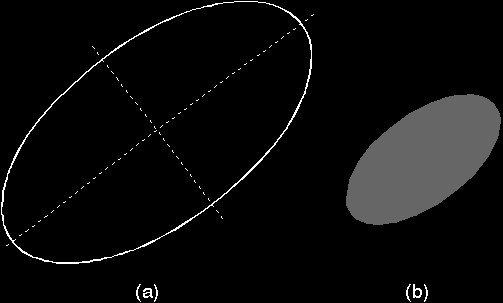To define a circle as the current arc, (r,q) and (p,s) can
be any such value that they lie on a circle. For example, if (r,q)
and (p,s) are set to (-4, 3) (3,4), the current arc is a circle with
a radius of 5 coordinate units. For simplicity, a circle can be defined
by specifying current arc parameters where p is the radius of the
circle, and p = q, r = 0, and s = 0.
For example, to define a circle centered on the origin and with a radius
of 10 world-coordinate units, use GpiSetArcParams
with the values (0,10) (10,0).
The default values of the current arc parameters are (0,1) (1,0), which
define a circle with a radius of one world-coordinate unit (a unit circle).
GpiFullArc Input Parameters
GpiFullArc accepts as input a
multiplier value, so that the size of the full arc is increased or decreased
in relation to the current arc. For example, if the current arc parameters
define an ellipse whose major axis is 20 coordinate units and whose minor
axis is 8 coordinate units, a multiplier of 2 in GpiFullArc
creates an ellipse whose major axis is 40 coordinate units and whose
minor axis is 16 coordinate units.
Because the arc parameters are integers when a fraction is required, for
example when rotating an ellipse, greater precision can be obtained by scaling
up the required arc parameter values as much as possible, then using a multiplier
smaller than 1 to scale the ellipse back down to the required size.
With the default arc parameters defining a circle of 1 world coordinate
unit, you can draw a circle of any size by allowing the arc parameters to
default, then specifying the radius of the circle with the GpiFullArc
multiplier. For example, to draw a circle with a radius of 12 coordinate
units, call GpiFullArc with a
multiplier of 12 and allow the GpiSetArcParams
to default. Since GpiFullArc,
like GpiBox, can be used to define
a closed figure, it also accepts as input a long value signifying a filled
interior. The long value, IControl, can be:
Value
DRO_OUTLINE
DRO_FILL
Fill the arc interior only.
DRO_OUTLINEFILL
Draw the arc and fill its interior.
The pattern that fills the interior and other drawing options are controlled
by the data structure AREABUNDLE. See Area
and Polygon Primitives for detailed information on using areas.

The Full Arc
(a) is a tilted ellipse that is defined by the current arc parameters. (b)
is drawn using GpiFullArc with:
- A multiplier value that reduces the size of the arc
relative to the current arc �
An
IControl value filling the interior with the current area-fill pattern,
but not drawing the arc's outline.
[Back]
[Next]
